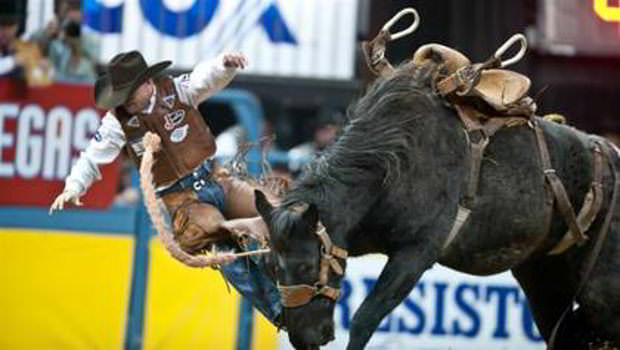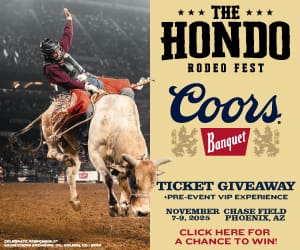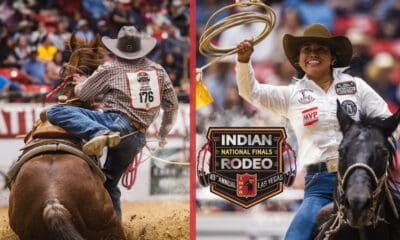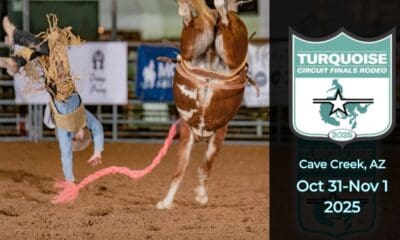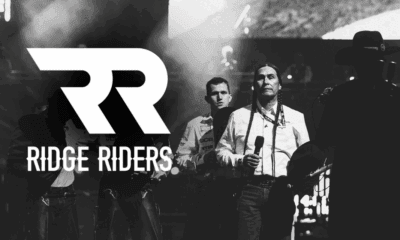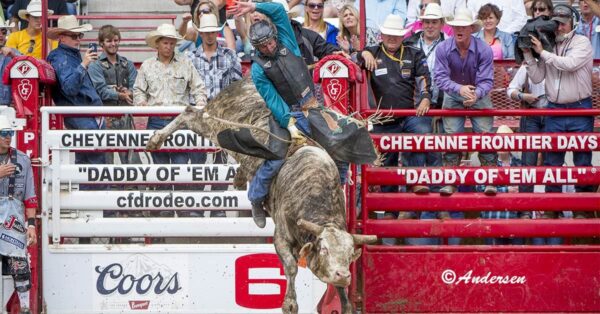Cowboy Lifestyle Network Highlights Rodeo Events at the 2013 NFR
CLN is giving you all of the information you need to know about all rodeo events you’ll be seeing during the two weeks of non-stop action at the NFR!
Rodeo News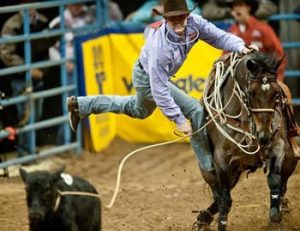
Tie Down Roping
It’s the most wonderful time of the year, and no, we’re not talking about Christmas. It’s time, once again, for the biggest rodeo of the year – the Wrangler National Finals Rodeo! The Cowboy Lifestyle Network is giving you all of the information you need to know about all of the incredible rodeo events you’ll be seeing during the two weeks of non-stop action at the NFR!
Tie-Down Roping:
The tie-down or calf ropers enter the “box” on their horses. Once they are in the box, you will see a rope that is stretched across the front of the box. This is known as the “barrier.” Once the horse’s hind end is flush with the corner of the box and the cowboy nods his head, the calf is released. The calf must trigger the barrier line to retract before the horse does; otherwise this is considered “breaking the barrier” and results in a 10-second penalty.
Once the cowboy ropes the head of the calf, he must dismount his horse and “flank” the calf by picking it up and flanking it on its side. If the calf falls, he must allow the calf to first stand and then flank the calf. At that point, the cowboy takes the “pigging string” out of his mouth and ties any three legs together. The calf must stay tied for six seconds for the cowboy to get a qualified time; otherwise, it’s a no time.
Steer Wrestling:
Started much like tie-down roping, a steer wrestler enters the box and squares up once the barrier is set. On his other side is the “hazer” whose job it is to make sure the steer runs straight. Once the steer wrestler or bull dogger nods for the steer to be released, he jumps off and literally wrestles the steer to the ground by hooking his right arm under the steer’s horns and pulling. The timer is only stopped once all four of the steer’s feet are pointed in the same direction. An extra 10 seconds is added if the cowboy breaks the barrier.
Saddle Bronc Riding:
Known as the event that started rodeo, saddle bronc riding has its roots in breaking horses to ride. Unlike a regular horse riding saddle, there is no saddle horn in a saddle bronc saddle. A cowboy gets into the chute, grabs his braided hack rein and nods his head. Just as in bareback bronc riding, he must adhere to the “markout” rule. He then must spur in a fluid motion from the horse’s shoulders to the back of the saddle for a total of eight seconds. If his free arm touches any part of the saddle or the horse, he receives a no score. There are 100 points possible: 50 for the horse and 50 for the cowboy.
Bareback Bronc Riding:
Often regarded as the toughest rodeo event on a cowboy’s body, these brave men stick their hands in a “rigging” on the back of a bucking horse. As they leave the bucking chute, they must “mark out” or keep their heels above the point of the horse’s shoulders, otherwise the out will be considered a no score. Once out of the chute, they almost resemble rag dolls as they alternately spur and bring their feet away from the bucking horse in motion for eight seconds. You will notice that they wear a thick neck roll that attempts to protect them from the jostling and jarring they are subjected to while bouncing against the back of a bucking horse. The cowboy must not touch the rigging or the horse with his free arm. There are 100 points possible: 50 points for the cowboy and 50 points for the bucking horse.
Team Roping:
Team roping includes two cowboys: the header and the heeler. The header must rope the head of the steer. There are three legal ways to catch the steer: around both horns, around the neck or around one horn. Any other catch is considered illegal and results in a disqualification. Once the header brings the steer around to the right, the heeler must rope the steer’s legs. Roping only one leg results in a five-second penalty. The clock stops when both ropers are “dallied up” or taunt and are facing each other. Breaking the barrier results in a 10-second penalty.
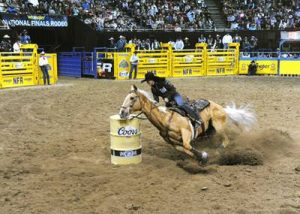 Barrel Racing:
Barrel Racing:
The only women’s event in the PRCA, these ladies are fast! They run the barrels in a clover pattern. They can either go to the left or the right and must run as fast as they can without knocking the barrels down. A knocked barrel results in a five-second penalty.
Bull Riding:
The bad boys of rodeo, these cowboys wrap their hand in a bull rope that is reinforced with sticky rosin that the cowboys heat up by rubbing their hands up and down on the rope. Once the chute opens, they must ride the bull for a total of eight seconds. If the cowboy’s free arm touches the bull at all, it’s considered a no score. There are 100 points possible: 50 for the cowboy and 50 for the bull.
Last Updated on 09/28/2019 by Gabriella Jaffee
CLN Community Sponsor
